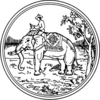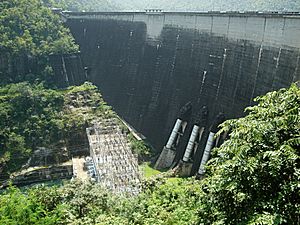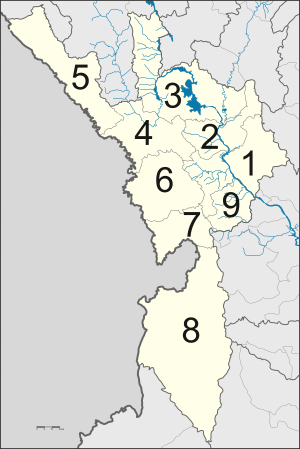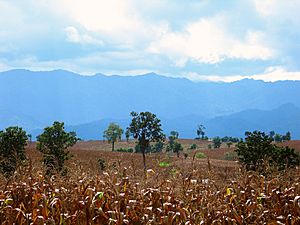Tak province facts for kids
Quick facts for kids
Tak
ตาก
|
|||
|---|---|---|---|
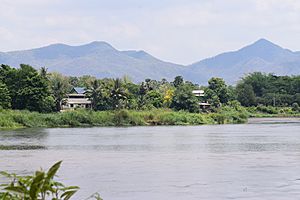
Ping River
|
|||
|
|||
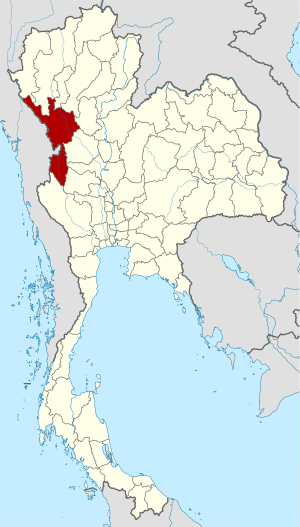
Map of Thailand highlighting Tak province
|
|||
| Country | Thailand | ||
| Region | Lower northern | ||
| Capital | Tak | ||
| Largest City | Mae Sot | ||
| Area | |||
| • Total | 17,303 km2 (6,681 sq mi) | ||
| Area rank | Ranked 4th | ||
| Population
(2019)
|
|||
| • Total | 665,620 | ||
| • Rank | Ranked 39th | ||
| • Density | 39/km2 (100/sq mi) | ||
| • Density rank | Ranked 76th | ||
| Human Achievement Index | |||
| • HAI (2017) | 0.5631 "low" Ranked 61st |
||
| Time zone | UTC+7 (ICT) | ||
| Postal code |
63xxx
|
||
| Calling code | 055 | ||
| ISO 3166 code | TH-63 | ||
Tak (Thai: ตาก) is one of Thailand's 77 provinces. It is located in the lower northern part of Thailand. Tak shares borders with many other provinces. These include Mae Hong Son province, Chiang Mai province, Lamphun province, Lampang province, Sukhothai province, Kamphaeng Phet province, Nakhon Sawan province, Uthai Thani province, and Kanchanaburi province. To the west, Tak has a long border with Kayin State in Myanmar (formerly Burma).
Contents
Exploring Tak's Geography
Tak province is a large area, covering about 17,303 square kilometers. It is located about 426 kilometers north of Bangkok. A big part of the province, about 72%, is covered by forests.
Important Dams and Rivers
The Bhumibol Dam is a very important landmark in Tak. It was built between 1958 and 1964. This dam holds back the Ping River, which is one of the main rivers that form the Chao Phraya River. The lake created by the dam is huge, covering 300 square kilometers. It is the largest artificial lake in Thailand.
National Parks and Wildlife Sanctuaries
Tak province is home to several beautiful national parks. These parks protect nature and wildlife. Some of the national parks here are Taksin Maharat National Park, Namtok Pha Charoen National Park, Lan Sang National Park, and Khun Phawo National Park.
There are also important wildlife sanctuaries. The Thungyai Naresuan Wildlife Sanctuary and Huai Kha Khaeng Wildlife Sanctuary are partly in Tak. These two sanctuaries are so special that they are recognized as World Heritage Sites.
Mountains and Borders
On the western side of Tak, you'll find the Tenasserim Hills and the Dawna Range. These are mountain ranges. One of the main roads that crosses into Myanmar is located at Mae Sot in Tak province.
A Look at Tak's History
Tak has a very long history, going back over 2,000 years. It was an important kingdom even before the famous Sukhothai kingdom. Around the 1st century, this ancient kingdom was at its strongest.
Later, around 663 CE, a city called Ban Tak was founded by Princess Jamadevi from the Lavo kingdom. This city became a key fortress for the Sukhothai kingdom on its western border.
The city of Tak moved a few times over the years. During the time of the Ayuthaya kingdom, it was moved west and called Mueang Rahang. Then, in the early Bangkok period, it was moved back to the east side of the Ping River.
A famous king, Taksin, was once the vice-governor of Tak. His original name was Sin. He became known as Tak-Sin because of his time serving in Tak.
People of Tak: Demographics
About a quarter of the people living in Tak province belong to different hill tribes. These groups include the Yao, Karen, Akha, Lahu, Hmong, and Lisu. The largest hill tribe group in Tak is the Karen people.
Refugee Camps in Tak
Tak province also hosts several refugee camps. These camps provide a safe place for people who have come from Burma. One of the largest camps is Mae La refugee camp, which houses many Karen refugees.
How Tak is Governed
Tak province is divided into nine main areas called districts (amphoes). These districts are then split into smaller areas called subdistricts (tambons) and villages (mubans).
- Mueang Tak
- Ban Tak
- Sam Ngao
- Mae Ramat
- Tha Song Yang
- Mae Sot
- Phop Phra
- Umphang
- Wang Chao
Symbols of Tak Province
The official seal of Tak province shows King Naresuan riding on a royal elephant. This image represents a very important moment in history. King Naresuan is shown pouring water, which was a way to declare independence from Burma in 1584. Tak was the first border town to be freed.
The province's slogan tells you about its beauty: "A town of wonderful nature, huge Bhumiphol Dam, King Taksin The Great and beautiful forests."
The official tree of Tak is the Asian Jatoba (Xylia xylocarpa). The provincial flower is a type of Orchid tree (Bauhinia sp.).
Health Services in Tak
Tak province has two main public hospitals. These are Somdejphrajaotaksin Maharaj Hospital and Mae Sot Hospital. Both are run by the Ministry of Public Health.
Tak's Economy and Tourism
Agriculture is a big part of Tak's economy. Farmers in Tak grow many things like rice, corn, vegetables, and fruits. They also raise beef cattle and tilapia fish. Other industries in Tak include granite quarrying and making jewelry.
Handicrafts and products from Myanmar are also important for trade in Tak. The Bhumibol Dam is a popular place for tourists to visit. In the southern part of Tak, many people enjoy ecotourism, especially during certain seasons. Popular activities include visiting Thi Lo Su Waterfall and Thi Lo Le Waterfall, hiking, and white water rafting.
Tak is also famous for its special Loi Krathong festival. During this festival, many small boats called krathongs are floated down the Ping River in a long line. This happens in Mueang Tak District on Loi Krathong night.
Getting Around Tak: Transportation
Tak is an important place for travel in northern Thailand. Three major Asian highways pass through the province. AH1 connects Tak to the Myanmar-Thai border at Mae Sot District. AH2 runs through the province from north to south. Also, AH16 ends in Tak.
Tak province also has its own airport, Tak Airport, for air travel.
Human Achievement Index in Tak
The Human Achievement Index (HAI) measures how well people are doing in different areas of life. It looks at things like health, education, and income. In 2017, Tak province had an HAI value of 0.5631, which is considered "low." This placed Tak 61st out of all the provinces in Thailand.
See also
 In Spanish: Provincia de Tak para niños
In Spanish: Provincia de Tak para niños



